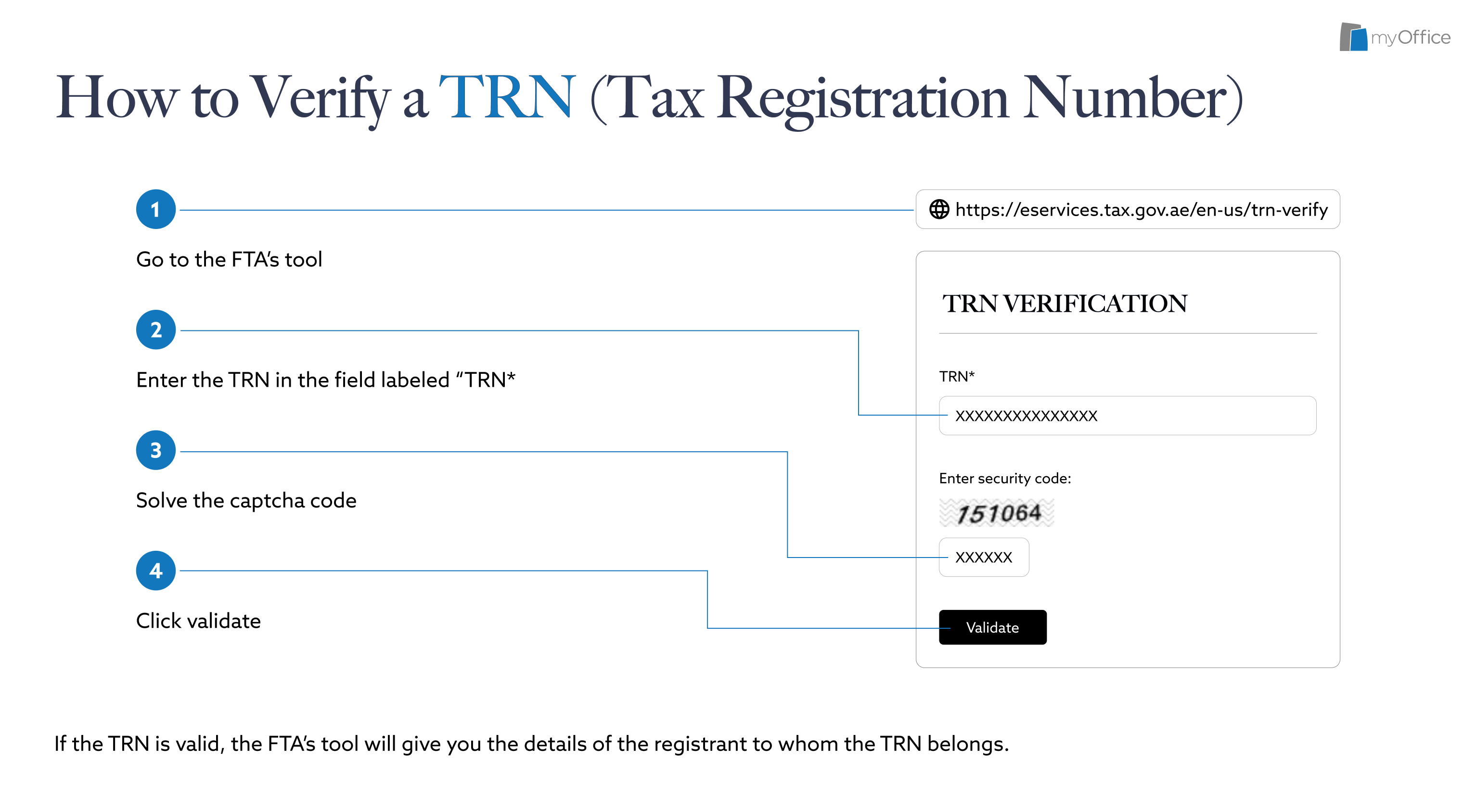VAT Registration in UAE 2025: Application, Changes and Cancellation
Value-added Tax, or VAT, is a tax imposed on the consumption or use of goods and services. Businesses collect and account for the tax on behalf of the government.
Value Added Tax (VAT) was first introduced in Dubai and the rest of the United Arab Emirates (UAE) on 1st January 2018 to diversify the country’s economy by adding new revenue sources. Since this introduction, VAT has been an important part of the UAE’s tax system, affecting both business set ups and consumers alike.
Here is a detailed guide on VAT registration
Who is Eligible for VAT Registration in Dubai
If the taxable supplies and imports of a business based in the UAE exceed AED 375,000 per annum, then they are eligible for VAT registration.
On the other hand, if a non-UAE-based business makes taxable supplies in the UAE, it is eligible for VAT registration, regardless of its value, and where no other person is obligated to pay the due tax on these supplies in the UAE. VAT registration is optional for businesses whose supplies and imports exceed AED 187,500 annually.
It is important to emphasise that while businesses pay the government the tax they collect from customers, they can also receive a refund from the government on the tax they as an entity incur or pay to their suppliers.
Foreign or non-UAE-based businesses may also recover the VAT they incur when visiting the UAE.
Step-by-Step VAT Registration in UAE

Registering for VAT in Dubai and the rest of the UAE is a crucial step for businesses that meet the eligibility criteria. The process ensures compliance with local tax regulations and helps companies avoid penalties.
While the procedure may seem complex, following the correct steps can make VAT registration straightforward and hassle-free.
Here’s a step-by-step guide to help you through the application process.
-
Check Eligibility
Before you register for VAT, check if your business is eligible for mandatory or voluntary Value Added Tax registration.
-
Document Preparation
Collect all the necessary documents and information to register for VAT in the UAE.
-
FTA Account Creation
Visit the Federal Tax Authority’s web portal to create an e-service account. Through this, you can access the VAT registration form and other services.
-
Complete the Form
Once you have created your account, log in and complete the online value-added tax registration form. You will be asked for details about the business, including the nature of its activities, turnover, and bank details.
-
Submit the Application
Once you’ve completed filling out the form, review it to make sure the details are accurate, and then submit it.
-
Payment
The Federal Tax Authority website has clear instructions on the fee for registration and the available payment methods. Pay the required fee as instructed.
-
Supporting Documentation
You will need to submit supporting documents to the FTA to verify the accuracy of the information you have provided.
-
Application Review
As the final step, the FTA will review the application, and if approved, it will issue a Tax Registration Number (TRN) and a VAT Certificate. This number and registration certificate are crucial as they identify your business for tax purposes.
The VAT registration process typically takes around 30 days. Any business trying to get a VAT registration number should follow these steps to submit the necessary application form to the Federal Tax Authority (FTA). Outsourcing PRO services can be a good option to help businesses navigate these legalities.

How to Check if Your VAT Registration Number Is Valid?
Verifying the validity of your VAT registration number in the UAE is essential to ensure your business complies with tax regulations. A valid VAT number confirms that your business or the entity you are dealing with is registered with the Federal Tax Authority (FTA).
VAT registration helps prevent fraudulent transactions and ensures that VAT collected or paid is properly accounted for. Checking the VAT number is especially important when dealing with new suppliers, clients, or partners to avoid legal and financial complications.
To check if a VAT registration number is valid, visit the official FTA website and use their VAT verification tool. Simply enter the VAT number into the designated field, and the system will display the registered business name and VAT status if the number is valid.
What Is a VAT Registration Number
The VAT registration number is a unique code that every registrant is required to print on their VAT invoice. It is often referred to as the TRN (Tax Registration Number). The FTA uses this TRN to identify businesses and keep track of their transactions.
If you register for VAT and want to check if your TRN is valid, you can perform a quick verification process.
The Tax Registration Numbers have a specific and unique format in Dubai. The TRN is a 15-digit number, the first three digits being 100. An authentic TRN has the format: 100-xxxx-xxxx-xxxx.
A fake TRN could have less or more than 15 digits, a starting number that isn”t 100, or an improper format.
While it is good to do visual inspections, you shouldn’t solely rely on them because sometimes a fake TRN will look the same as an original. To check if a VAT registration number is valid, it is always best to use the FTA’s tax verification tool.

Documents required for VAT registration in the UAE
- Trade Licence
- Memorandum of Association (MOA)
- Bank Account Details
- Email ID and Contact Details
- Office Address
- Yearly Turnover Report
- Customs Details
- Emirates ID of Partners
- Power of Attorney Documents
- Other Documents as Required
How to Change the VAT Registration Details
If you need to update your VAT registration details in Dubai, you must do so within 20 business days to comply with Federal Tax Authority (FTA) regulations.
Some changes can be made without FTA approval, whereas others require approval and need to be reviewed by the tax authority for VAT in the UAE.
Sections That Don’t Require Approval from the FTA
- Business activities of the applicant: This can include changing the primary activity or adding a new one
- GCC activities: This includes providing TRN, GCC member state, or estimated values of imports and exports
- Customs registration: Information about the CRN number, the emirate’s name, or uploading a new file.
Follow these steps to change any of the above sections
- Visit FTA’s online portal for VAT registration
- Find your approved registration application under the Dashboard tab
- Select “Edit”
- Click “Submit Changes,” and the updates will reflect automatically on your profile
Sections That Require Approval From FTA
- Details of the Applicant
- Contact details
- Banking details
- Business relationships
- About the VAT Application
- Declarations
Follow these steps:
- Access the FTA portal to fill out your approved VAT registration form.
- Click the “Amendment” button, then edit sections as needed.
- Tick “Review and Submit” once you are sure the information is correct.
How to Cancel VAT Registration in the UAE

VAT deregistration in the UAE is an online procedure that is done through the FTA portal. However, before that, businesses that have stopped operating should obtain a company liquidation letter from the Government authorities to cancel VAT registration.
Similarly, as per Article 17, businesses cannot apply for VAT Deregistration within 12 months from the date of Tax Registration.
Anyone trying to understand how to cancel VAT registration online should follow:
- Fulfil all the criteria to deregister for VAT in Dubai and the rest of the UAE.
- Log in to the VAT Account on the FTA Portal.
- Fill out the VAT deregistration. You will have to provide details of your business and the reason for the VAT deregistration.
- You will receive an SMS confirmation on the registered number for submission.
- Submit the form electronically.
Once the VAT deregistration is submitted to the FTA, they will check if all the conditions are valid; if not, they may reject the application for deregistration.
Sometimes, the application status shows as “Pre-Approved.” It will be “Approved” only when you clear all the pending liabilities.
Types of VAT Penalties in Dubai
Non-compliance with the UAE VAT rules can result in substantial fines and penalties. Here are some of the common VAT penalties in the UAE:
Late VAT Registration Penalty
The VAT penalty in the UAE for late registration was AED 20,000 before, but it has been revised to AED 10,000 as per Cabinet Decision No. (49) of 2021, issued on April 28, 2021.
Late VAT Deregistration Penalty
Delayed deregistration sums up to a VAT penalty of AED 1000 with an additional monthly penalty of AED 1,000, capped at a maximum of AED 10,000.
Late VAT Return Filing Penalty
The VAT law in the UAE requires a business to file a VAT Return within 28 days of the end of the tax period. Failing to do this within the specified timeframe can result in a VAT penalty of AED 1,000 for the first offence.
If there are repeated delays or non-compliance within a period of 24 months, the penalty increases to AED 2,000. In some cases, the FTA can also take legal action against such continuous delays.
Late VAT Payment Penalty
Failing to pay tax within the specified timeframe results in penalties. The calculation for this late VAT penalty in Dubai is as follows:
- An instant penalty of 2% on the unpaid tax is due right after the deadline.
- A 4% additional penalty on the unpaid tax on the seventh day following the deadline.
- A 1% daily penalty is applicable on any amount not paid within one month after the deadline. This is capped at a maximum of 300% of the original tax amount.
Frequently Asked Questions
How long does VAT registration take in Dubai and the rest of the UAE?
VAT registration usually takes 20 to 40 working days, depending on document accuracy and business complexity.
Is there a fee for VAT registration in the UAE?
VAT registration is free through the FTA portal. However, an AED 500 fee applies if you request an attested registration certificate.
What is the minimum revenue for VAT registration in the UAE?
Businesses must register if their annual taxable turnover exceeds AED 375,000. Voluntary registration is allowed for turnovers above AED 187,500.
Why is VAT registration necessary?
VAT registration ensures compliance with UAE tax laws, lets businesses charge VAT on taxable goods and services, and allows them to claim input VAT on purchases.
How long do I have to cancel my VAT registration?
Eligible businesses must apply for VAT cancellation within 20 business days of no longer meeting the registration criteria or stopping taxable activities.
What are the VAT penalties in the UAE?
Penalties vary, late registration’s fine is AED 10,000 while late filing or incorrect returns range from 2% to 300% of the tax due, depending on the delay and severity.

Leave a Reply